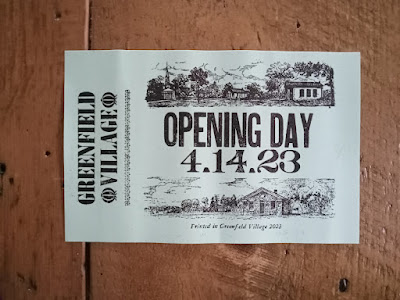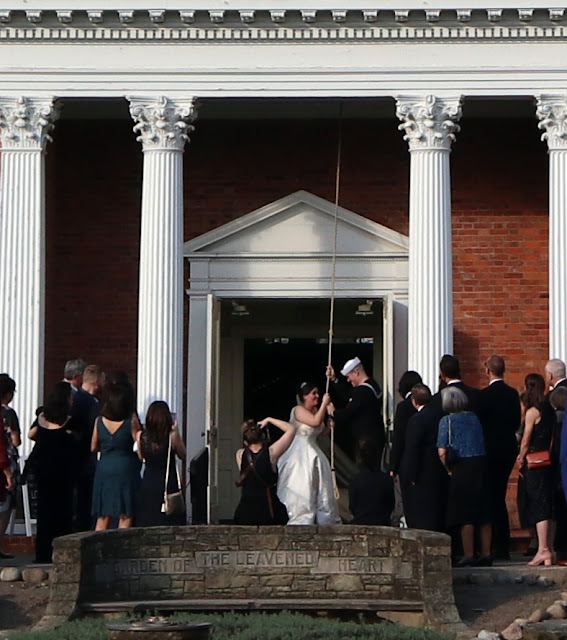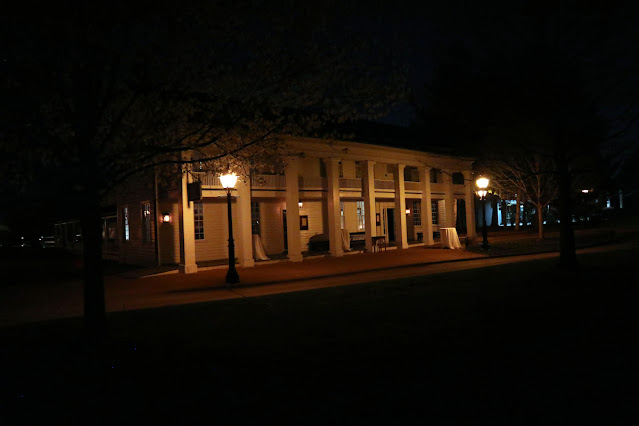If you say "Opening Day" around these parts of southeastern lower Michigan, most everyone thinks of the Detroit Tigers home opener...of the baseball season. But there are a great many of us who think a bit differently; thousands of us think of Greenfield Village when we hear "Opening Day."
And that's what today's posting is all about - - -
..................................................
Closed since the last evening of the wonderful Holiday Nights program on December 28th, 2022, Greenfield Village finally reopened its gates on Friday, April 14, and it was like a "Welcome Home" celebration for so many of us.
And a celebration it was!
 |
| A gift from the print shop~ |
Those of us who are Members of The Henry Ford, which includes Greenfield Village, pay one flat annual rate and can then visit as often as we want for the year, except when the Village closes from (roughly) January through mid-April, and by that time we are itching to return. Now, one might think we'd be bored visiting so often, but we are not...not at all.
And for a variety of reasons:
~seeing our presenter friends. And they are our friends...neighbors, even, in a way.
~ it is also a place to walk and clear one's head...to get away from modern anything, even for a short while (kind of like the way the Bloom County comic strip at the bottom of this post shows - with my own modification).
~ many, many photo opportunities. That goes without question.
~but mostly, for me, just to be in the midst of all that history - - - - - - I can't fully explain, but with 300 acres of land hosting nearly 100 historic structures dating from the early 1600s through the turn of the 20th century, it just feeds my passion for the past until my cup runneth over.
And it's here where we can see - witness - the seasons as they change...not just the seasonal change of our equinoxes and solstices, but of the daily life changes that accompany the seasonal changes. I do especially enjoy seeing the way history is presented throughout the year as it would have been in times past.
For instance:
spring - plowing, harrowing, planting, and cleaning
summer - haying, 4th of July celebrations, summer harvest, and period baseball
autumn - fall harvest and food preservation, wool spinning & dyeing, beer brewing, and winter preparations
There is also Motor Muster, Old Car Festival, 4th of July, Hallowe'en, Christmas, and other events throughout the year.
 |
| Greetings! |
The only season the average visitor is not able to enjoy in Greenfield Village is winter (and if you click the link, you'll see snowy photos taken inside the Village). We used to be able to have winter visits many years ago, but they now shut down for the first three and a half months of the year, and so those of us who love "seasonal history" in this part of the country either have to travel a ways to experience wintertime past or just read about old time winter activities. Unless you are a living historian and can plan period winter activities (as a few of us do - click HERE, HERE, and HERE). As for Greenfield Village, from what I understand, these winter months are used for cleaning and repairs in preparation for the rest of the year.
Anyhow, due to the fact that they are closed for so long, Opening Day in mid-April is cause for celebration for us history buffs. Yeah, let the media clamor over the Detroit Tigers' opening day (where they tend to lose more than win); million dollar sports stars ain't got nothing on our country's past!
So it was on this Friday, April 14th, here in 2023 - a members-only Opening Day - where so many of us enjoyed God's blessings of a beautiful summer-like 81 degree spring day, with the sun shining down, allowing for warm rays to reign upon us - perfect weather for our excursion.
Of course I had my ever-present camera with me and took plenty of photographs of this exciting first day.
AND...I also dressed for it - - - -
I hope you enjoy what I have here:
 |
| Posing in front of my favorite house. It was so good to be able to visit again. |
 |
| The three of us 18th century visitors visiting with a few Daggett presenters. |
 |
| Emily spun on the walking wheel. It's been a few years since I've seen her in Daggett clothing - - I didn't even recognize her! |
 |
| Preacher Gerring - Norm (18th century minister living historian) - joined me on this day, and we spent most of our time over where the 18th century houses were at. |
 |
| The ever-talented Roy was fixing the hoops on a beer barrel. |
 |
| I look like I am waiting for him to repair my barrel! Perhaps I stepped in a time zone and he is...~~~ Yes, I am wearing a bit of a higher-class clothing than I normally wear. |
 |
| Another "must stop" for me is the Plympton House, especially with Patriots Day - April 19 - less than a week away. In this photo, perhaps I am Thomas Plympton asking the local preacher to bless our Sudbury, Massachusetts militia as they prepare to match to Concord to help stave off the Redcoats on this Revolutionary Day! (click HERE to learn more about this house's Revolutionary War connection) |
 |
| Preacher Gerring sure gets around - he is leaving the home of shipping merchant, John Giddings. |
And inside the 18th century urban Giddings house:
 |
| We had a well-deserved meal at the Eagle Tavern |
Something interesting happened over the winter months:
I went back to the Village the next day, on April 15, and took a few more pictures. I didn't take as many as I would have liked to, for we came very late in the afternoon, but I did get some goodies:
And here is where this mill once stood over a hundred years ago:
Okay folks!
Off to the reception, which is only a few steps from the chapel:
I've often heard of weddings being held in the chapel and the party afterward here in the tavern, but I never dreamed I would one day be able to attend such a ceremony.
I've mentioned before that the historians at Greenfield Village are always researching the history of structures and items they have as part of their collection. Well, the proof is in the pudding, right?
Well, check out the windmill in the photo below:
 |
| This windmill sits in the Ford yard, and has done so for all the years I've been going there, which is a mighty long time. |
Now read the words imprinted on the newest placard inside Greenfield Village:
So this day was a wonderful day all around. I did not get nearly as many photos outside of our little 18th century world than I would have liked, but that's mostly due to the fact that when I am in my period clothing I try not to pull out my camera with people around (yes, I mostly use an actual object that's made for a specific job lol). So, for this opening day we mostly concentrated on ourselves and the time we had being a part of the past.
But...I did go back for a scant Village visit the next day - the "official" opening day for the general public.
 |
| I had to visit Firestone Farm! It's been since last November - this is one of the structures not open for Holiday Nights. |
 |
| And for the first time since before covid, they're cooking again - - just like at Daggett! Good to see you Kelly! |
 |
| Mackenzie is taking care of a knitting project in the sitting room. |
 |
| The Firestone Farm Field is nearly ready for planting. |
 |
| This circa 1850-51 carding mill - built by John Gunsolly - was originally located near Plymouth, Michigan on the Middle Rouge River, and illustrates the changeover from hand-operated (carding paddles) to labor-saving mechanical equipment brought about by the industrial revolution, which resulted in the mass production and mass supply of goods. |
 |
| I am imaging the carding mill and perhaps another (saw mill?) along the river in the distance (going from left to center). And, wait, there are horses and carts as well. Use your imagination - they're there! |
 |
| This is the house the Wright Brothers were living in with their father and sister (their mother had already passed) during the time they devised and flew the first real aeroplane. |
 |
| Now we see the Ford Farm, in which Henry Ford was born in 1863. |
 |
| The opposite side of the Ford Farm - we see a farmer in the field. Perhaps Henry himself? |
On this very same weekend - on general public Saturday, in fact - my wife and I were honored to be invited to a wedding of our long-time reenacting friend, Emily.
Emily used to reenact the Civil War with us a decade (and more) ago. She portrayed what we call an "ice angel" - a position not actually from the Civil War era, but pretty important for reenactors, for during and after battles she would venture out onto the battlefield with her bucket of water to keep the "dead" and "wounded" hydrated, just in case they lost their canteen water.
Well, now, our Emily has just gotten married.
You may be wondering why I'm incorporating Emily & Josh's wedding into today's post. Why, because they were married at Greenfield Village!
I'm not going to post all the pictures I took - just a few of the ceremony and more of the reception - more history-based photos that I hope you'll like:
 |
The grounds of the big event - across the Village Green. That's the Martha-Mary Chapel in the center, where the wedding took place, and the 1831 Eagle Tavern on the left, where the reception was. This non-denominational chapel design was based on a Universalist church in Bradford, Massachusetts. Built inside Greenfield Village the year it opened - 1929 - the bricks, doors, and door knobs came from the building in which Henry Ford and Clara Bryant were married in 1888 - the Bryant family home in old Greenfield Township. The name "Martha-Mary" came from the first names of his mother and mother-in-law. |
 |
| My own sort of 'artsy' kind of photo incorporating both the tavern sign and the chapel. |
I did not get a wide-angle shot inside the chapel, so we'll jump to after the ceremony had ended:
 |
| The honored guests of the bride and groom await outside in the perfect spring weather for the newlyweds to come out to ring the bell. I decided to fall back a bit to get this unique picture that I don't believe anyone else got! |
 | ||
| Both Emily and Josh yanked hard on the rope to ring the bell. Joseph Warren Revere cast the circa 1834 bell they were ringing. Revere was the son of the famous silversmith Paul Revere, who had an extensive knowledge of metallurgy and opened his own foundry in 1792. This bell hung in the belfry of the Universalist Church in Hingham, Massachusetts from 1834 to 1927, before being installed at the Martha-Mary Chapel in Greenfield Village.
|
Paul Revere has been a hero of mine since I was a young elementary school lad, so to see these two young ones pull the rope and then to hear this bell sent shivers. It was indescribable to me.
Off to the reception, which is only a few steps from the chapel:
 |
| The 1831 Eagle Tavern. Click HERE to learn more about this stage-coach stop. |
And, thanks to the two young people below, I now have!
The night got later - time for us to leave. But as I walked outside the tavern door, the lit glow of the Martha-Mary Chapel caught my eye:
Then it was time to leave.
 |
| May God bless the two of you! |
 |
| The Eagle Tavern is always candle lit for guests, including wedding guests. That is the core of its charm. |
And then...
 |
| 1831 meets 2023~ I had to laugh a bit when the DJ began to do his thing to get people dancing: he played a variety of music...everything from Glenn Miller and The Beatles up to contemporary artists, of which I have no idea who they were, and then to add to that the flashing, swirling club lights, well, the spirits within the walls of this old stagecoach stop must've been a-reelin'! But we really had a whole lot of fun (in a sort of ethereal way lol)! |
 |
| I asked the newlyweds if they would pose for me - I'm so proud that they did - this is my favorite picture that I took. They are posing in front of the hearth, which is part of what was once the original kitchen. At one time the tavern food was cooked here. |
 |
| The bar keeps were on hand to serve any and all who desired a drink. At one point I ordered a sarsaparilla and a young lady who ordered a mixed drink of some sort made a comment to me: "ooooo....exotic!" which told me she didn't know what sarsaparilla was. She laughed when I explained it's the root - the original version - of root beer! |
 |
| So beautiful - the picture does not do it justice! |
 |
| And then I turned and saw the night time beauty of the tavern. |
 |
| So I sort of captured both. |
No, I did not wear my colonial clothing on that Saturday, though Emily suggested that I do. My wife and I chose not to - the wedding 'twas not the proper time to do so.
But it was one heck of a weekend, wouldn't you say?
Of course, you know I'll keep you updated on its move. They said it will take about three years to take it apart piece by piece, have it shipped north, then put back together. Many of the home's original artifacts dating to when Dr. King was there will be a part of the presentation.
It's always a good feeling knowing that Greenfield Village - my place of solace - is, once again, open to the public:
 |
| This was the cover of my Friends of Greenfield Village page over Opening Weekend. It did not get very many "likes" but that's okay. This one I put up for me. |
And I got to attend a wedding there to boot.
The rumors in the mill have stated that Friday's Members Only Opening Day had record-breaking attendance, where around 3,500 visitors showed up. I can tell you it was pretty doggone crowded!
The picture-perfect weather could not have been any better, that's for sure.
Yes, it was a fine weekend indeed!
~~~
And then on Monday, the date of this posting, in fact, this hit the news:
Henry Ford Museum To Preserve Civil Rights House
The Henry Ford, a 250-acre cultural destination and National Historic Landmark in Dearborn, Michigan acquired and will preserve the Selma, Alabama home of Dr. and Mrs. Sullivan Jackson. The historic home, known as the Jackson House, served as a safe haven where Dr. Martin Luther King, Jr. and others worked, collaborated, strategized and planned the Selma-to-Montgomery marches of 1965.
 |
| Soon this 1912 house will be moved from its Selma, Alabama location to its new home inside Greenfield Village in Dearborn, Michigan! |
I wonder where they plan to put it inside the Village?
Until next time, see you in time!
Happy Spring!
Happy Spring!
~ ~ ~









No comments:
Post a Comment